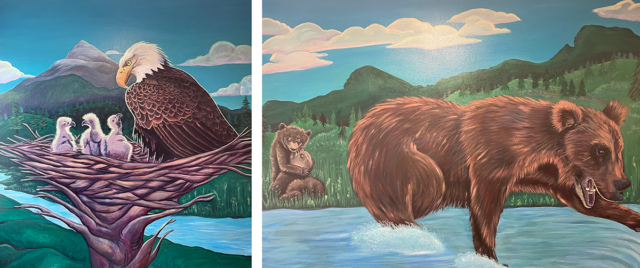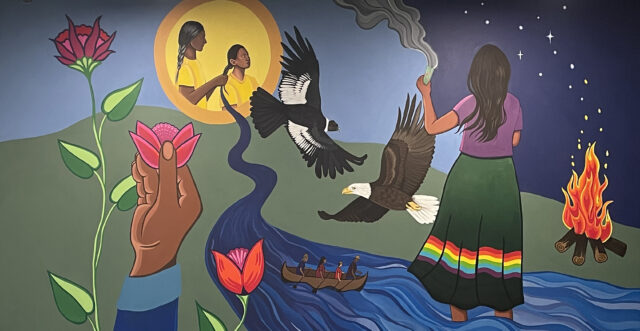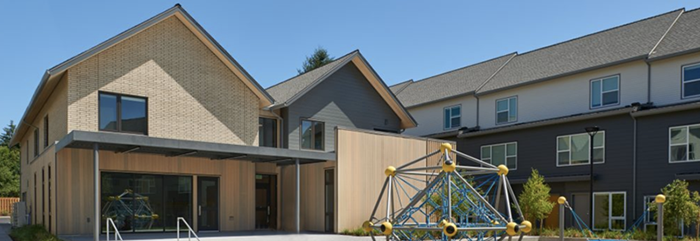NAYA opens first of its kind family shelter to provide critical housing for Native American families
khwat yaka haws, meaning “Auntie’s Place” in the Chinook language, is a vital resource designed to support Native families experiencing houselessness. Located in Milwaukie, its opening is a significant milestone in NAYA’s ongoing mission to provide culturally specific, comprehensive services to the Native community. The shelter adds a much-needed component to NAYA’s continuum of housing services, providing an entry point for Native families to access stable housing.
NAYA staff, community members, artists, and friends gathered at Auntie’s Place to commemorate the signing of the shelter’s lease in January. Songs, prayers, and a meal were shared, emphasizing the impact the shelter is expected to have for the families and community it will serve.
Attendees were asked for suggestions for naming the shelter. Thinking about Native families facing housing challenges, and the way that so many times, community Aunties open their homes to help, NAYA Director of Family Services Tawna Sanchez suggested “Auntie’s Place.” Referring to the shelter as “Auntie’s Place” helps to preserve the dignity of people who will be staying here and embodies many of NAYA’s core values including kindness, respect, giving, tradition, community and pride. NAYA elder Suzie Kuerschner introduced us to Valeria Atanacio, who generously provided the Chinook words for Auntie’s Place, khwat yaka haws.
The shelter includes eight private family rooms, each with the capacity for up to seven household members. Each room has a mini kitchen as well as a private bath, and one room is ADA accessible. Common spaces, including a community kitchen and laundry facilities are also part of this new shelter.
NAYA aims to reduce houselessness in our community by addressing both immediate and long-term needs. The shelter will provide a range of services, including access to traditional healing practices, educational and employment support, and assistance with navigating housing and social services including funding for longer term housing and supportive services.
Celebrating culture: murals welcome community home
Among the many highlights of the opening were the stunning murals that adorn the walls, created by a diverse group of talented artists, each bringing their unique perspectives and stories to the space.
Amaranta Colindres, a guest to the Pacific Northwest from Custcatlán (now El Salvador), brings a rich, multicultural perspective to her mural. Her heritage blends Nahuatl Pipil Mayan, Caribbean, and European influences, all of which inform her vibrant and harmonious nature scenes. Amaranta’s mural is a visual land acknowledgment featuring local plants and animals in a thriving, natural habitat. The focal point of one is a mother bear hunting for salmon, with her cubs safely tucked behind native foliage. The second work features a family of eagles, with little ones being cared for by an adult. The scenes evoke a sense of safety and stability, reflecting the refuge offered by Auntie’s Place.

Arusha Dittmer (Ho-Chunk Nation) drew from her own experiences with housing instability to inform her artwork. Understanding the struggles of those the shelter serves, Arusha aimed to create work that fosters healing and positivity. Her design highlights family and some of the first foods that have supported area communities for millennia. Images of camas flowers, salmon, and acorns are topped with the Portland skyline and surround imagery evoking strong familial bonds. Arusha’s work reminds us of the resilience and strength of Indigenous people and highlights the interconnectedness of communities across tribes.

Chanti Mañon (Osage and Mazahua) sees her art as a powerful tool for storytelling, reflecting the community’s hopes and values. With bold, vibrant colors, Chanti’s murals incorporate themes of inclusivity, Indigenous history, and culture. In the kitchen, her mural highlights local and vital first foods across Turtle Island, emphasizing the importance of nature and Indigenous history. In the lounge, her artwork depicts an elder braiding a youth’s hair and another figure smudging, symbolizing connection and community. Interwoven with imagery of rivers, canoeing, beadwork, plants, and animals, Chanti’s murals celebrate inclusivity and the healing power of art.

Leo Whitehorse (Rosebud Sioux Tribe,) a seasoned graphic and fine artist with over 30 years of experience, brought his expertise in advertising and sign painting to the murals of Auntie’s Place. A member of the Native American Arts and Crafts Market (NAACM) in Eugene, OR, Leo’s goal is to foster communication between native groups and create opportunities for native artists. His mural, inspired by the Rosebud Sioux Tribe, uses Ledger style artwork to depict themes of family, community, security, and heritage. Leo’s connection to his roots is evident in his work, which beautifully translates his upbringing into a vibrant, visual narrative that resonates with the residents of Auntie’s Place.

The murals at Auntie’s Place do more than decorate; they tell stories, celebrate heritage, and offer comfort and inspiration to the families who will call this shelter home. Each artist’s contribution adds a unique layer of meaning, transforming the space into a vibrant, welcoming environment, embodying the spirit of community and resilience. As Auntie’s Place begins its mission to support families, these artworks will stand as enduring symbols of hope and cultural pride.
The Mural Process
An important goal for our family shelter was to create a welcoming environment for Native families. Muralists were sought to celebrate Native culture in a space where families are rebuilding their lives. NAYA engaged with art organizations, artists, and Native community members to arrive at these common themes:
Uplifting Activism: NAYA received permission from Derrick Belgarde of the Chief Seattle Club who originated the phrase “Never Homeless Before 1492” to be included in the art at the shelter.
The Importance of Nature: Connection and Relationship to Land and Plants
Creating a Sense of Pride, Belonging and Representation
Inclusivity and Being Inclusive: Representative of Many Tribes, Local and non-Local, Celebrate the Diversity of our Culture(s)
Educational Opportunity by Sharing Indigenous History and/or Culture: Telling the History of Those Who Were Here Before Us
We thank our artists, Amaranta Colanders, Arusha Dittmer, Chanti Mañon, and Leo White Horse, for creating a culturally rich and welcoming home for our families.
